Related Research Articles
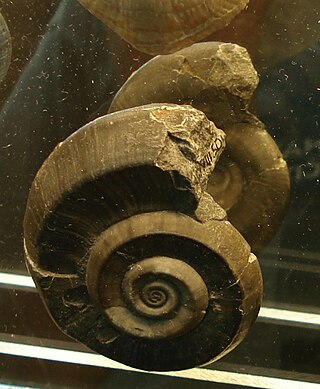
The Euomphalina comprise a major suborder of mainly Paleozoic archaeogastropods, shells of which are hyperstophic to depressed orthstrophic, commonly with an angulation at the outer upper whorl surface thought to be coincident with the exhalent channel; shell wall thick, outer layer calcitic, inner layers aragonitic but not nacreous; operculum calcareous and heavy. Their range is from the Upper Cambrian to the Triassic, and possibly as high as the Upper Cretaceous.

The gastropod shell is part of the body of a gastropod or snail, a kind of mollusc. The shell is an exoskeleton, which protects from predators, mechanical damage, and dehydration, but also serves for muscle attachment and calcium storage. Some gastropods appear shell-less (slugs) but may have a remnant within the mantle, or in some cases the shell is reduced such that the body cannot be retracted within it (semi-slug). Some snails also possess an operculum that seals the opening of the shell, known as the aperture, which provides further protection. The study of mollusc shells is known as conchology. The biological study of gastropods, and other molluscs in general, is malacology. Shell morphology terms vary by species group.
Rhaphischismatidae is an extinct family of fossil sea snails, marine gastropod molluscs in the superorder Vetigastropoda. They date from the Lower Carboniferous (Mississippian). The family contains a single genus, Raphischisma. In the Bouchet & Rocroi, 2005), this family is assigned to the Pleurotomariacea.
Bucaniidae is an extinct family of Paleozoic molluscs of uncertain position possibly being either gastropods or monoplacophorans in the superfamily Bellerophontoidea. The family lived from the Lower Ordovician to the Devonian and have shells in which the apertural margins tend to flare. Most genera have a slit and selenizone, others some modification of this feature.
The †Raphistomatidae is a taxonomic family of fossil sea snails, Paleozoic marine gastropod mollusks. This family was established by Koken in 1896. This family is found in the fossil record from the Upper Cambrian to the Middle Permian.

Euomphaloidea, originally Euomphalacea, is an extinct superfamily of marine molluscs that lived from the Early Ordovician to the Late Cretaceous, included in the Gastropoda but speculated as instead perhaps Monoplacophora.
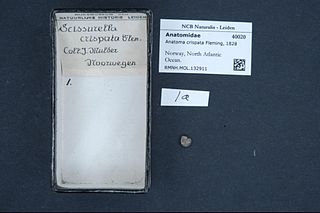
Anatoma crispata is a species of minute sea snail, a marine gastropod mollusk or micromollusk in the family Anatomidae.

Calliotropis infundibulum is a species of sea snail, a marine gastropod mollusk in the family Eucyclidae.
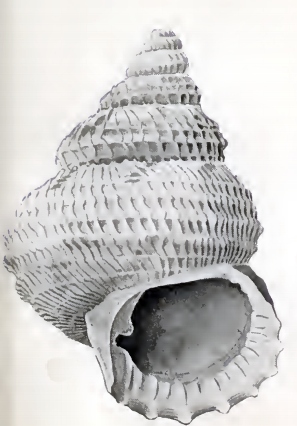
Danilia telebathia is a species of small sea snail, a marine gastropod mollusk in the family Chilodontidae.

Calliostoma yucatecanum, common name the depressed top shell, is a species of sea snail, a marine gastropod mollusk in the family Calliostomatidae.
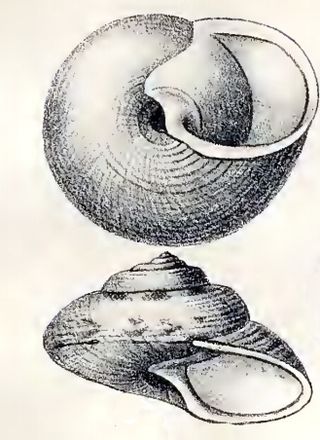
Callogaza watsoni is a species of sea snail, a marine gastropod mollusk in the family Margaritidae.

Gaza superba, common name the superb gaza, is a species of deep sea sea snail, a marine gastropod mollusk in the family Gazidae, the top snails.

In the shell of gastropod mollusks, the lip is the free margin of the peristome or aperture of the gastropod shell.

Megastraea undosa, common name the wavy turban snail, is a species of sea snail, a marine gastropod mollusk in the family Turbinidae, the turban snails. This species is native to the coast of California.
Sinutropis is a genus of fossil sea snails, extinct euomphalid archaeogastropods from the Upper Silurian.
Cantharidoscops frigidus, the polar margarite, is a species of sea snail, a marine gastropod mollusk in the family Trochidae, the top snails.

Coelotrochus viridis, common name the green top shell, is a species of sea snail, a marine gastropod mollusk in the family Trochidae, the top snails.
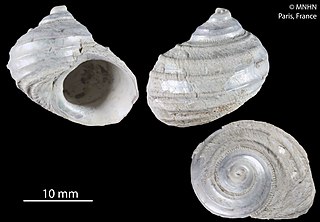
Cataegis finkli is a species of sea snail, a marine gastropod mollusk in the family Cataegidae.
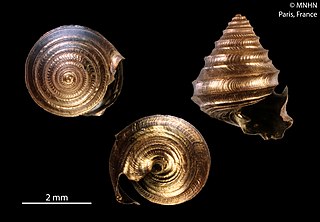
Seguenzia formosa is a species of extremely small deep water sea snail, a marine gastropod mollusk in the family Seguenziidae. The epithet "formosa" means "beautiful".

Trochus kochii is a species of sea snail, a marine gastropod mollusk in the family Trochidae, the top snails.
References
- ↑ (in German) Wenz W. A. (October) 1938. Handbuch der Paläozoologie, 6(1). Page 249.
- 1 2 3 J. Brooks Knight et al 1960. Systematic Descriptions (Gastropoda), Treatise on Invertebrate Paleontology, Part I, Mollusca 1, R.C. Moore (ed).
- 1 2 Anomphalidea in Paleobio database